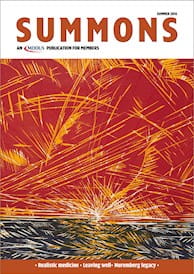
THE court had been in session for 139 days; it had heard the testimony of 85 witnesses and received more than 1,400 documents in evidence. Now the legal battle was over and the courtroom was hushed in anticipation of the outcome. Twenty-three defendants awaited their fate at the hands of a panel of American judges. The date was 19 August 1947; the court – the Palace of Justice in the bombed-out city of Nuremberg in occupied post-war Germany; the hearing one of the most famous in legal history – the Nazi Doctors’ Trial.
In a judgement running to more than 50,000 words, pronouncing the guilt of 16 of the defendants and sending seven to their deaths, a small introductory section of around 500 words entitled, “Permissible Medical Experiments” might have been overlooked. However, this was to be the enduring legacy of the trial – 10 carefully weighed and worded standards for the conduct of human research, which have since become known as the Nuremberg Code.
The precise authorship of the Code is unknown. The trial’s chief counsel for the prosecution believed it was from the hand of one of the four judges. Others have suggested that two physicians were the chief architects of the Code: Andrew Ivy and Leo Alexander.
Ivy was an eminent physician and physiologist who, perhaps because he had been actively involved in research involving prisoners, had been invited to serve as the American Medical Association’s adviser to the Nuremberg prosecutors. Alexander was an Austrian-born, American physician who served first as a medical war crimes investigator and then as medical expert to the trial.
Both men played an active role in the proceedings and they submitted several sets of ethical principles to the court. However, because of the lack of documentary evidence detailing the judges’ thinking while drafting their ruling, we can only speculate as to the relative importance of each man’s contribution.
The Doctors’ Trial
In the Doctors’ Trial, or more formally The United States vs. Karl Brandt et al, the 23 defendants were indicted on a number of counts, including war crimes and crimes against humanity.
As the war had neared its conclusion, details of the medical experimentation in concentration camps first began to reach the world press. The public needed no convincing that the Nazi doctors involved were guilty of unethical practices and almost unimaginable cruelty. In order for them to face criminal charges, however, the American prosecutors faced a dilemma.
The defendants would claim their innocence, stating that they were acting in accordance with German military law and that their American medical counterparts were involved in similar practices. As such, it was clearly paramount to distinguish the practices of the physicians in the dock from those of Allied researchers. The prosecution also had to define what they believed to be ethically permissible experimentation and what was not.
Within the final Code three main themes were evident. First that the absolute need for informed consent is a sine qua non of clinical research; second that a study participant’s rights are given precedence over those of the investigator; and third that the investigator has clear obligations regarding the design and conduct of the study.
It seems unthinkable today that the medical atrocities perpetrated in the Nazi concentrations camps could happen again, but what the authors of the Code still ask us to do is to contemplate that very possibility.
Reception
The Nuremberg Code was largely ignored by the medical profession for 20 years after its publication, especially in the US and the UK. This may have been due to the circumstances that prompted the Code – a series of medical atrocities conducted by Nazis during a war – that were seen as irrelevant and unconnected with medical practices in other countries.
Although some have viewed the Code as a component of International Common Law, it carried no legal force and was at best a voluntary code of research ethics. However, the voluntary nature of such a code may be viewed as its principal strength in that the best possible, and most liberated, scientific environments are created not within the straightjackets of legislation, but within the relative flexibility afforded by a professional guideline.
Unfortunately, against this contention is the evidence of history. Time and again we have learned that we cannot rely on the “informed, conscientious, compassionate, responsible investigator” guided merely by a voluntary code of conduct. For the safety of trial participants that investigator must also be constrained by the rule of law.
Relevance
The Nuremberg Code has been described by many as the most important document ever written on human research ethics. Is this true? Although largely ignored for around two decades, by the mid-1960s a number of important events had occurred that refocused professional and public attention on the issues. These included the publication of the Declaration of Helsinki in 1964, and catalogues of unethical human research in the post-war period compiled by the American anaesthetist Henry Beecher in 1966, and the English physician Maurice Pappworth in 1967. Collectively, these events pushed forward the need for change and tighter control of medical research.
The rapidly changing social and cultural backdrop of the 1960s may also have significantly contributed to this development. Every idea has its time, and in the late 1940s the medical profession was not ready to address the ethical issues central to the Code. By the 1960s, it was.
But what would the research ethics landscape look like today if there had been no Nuremberg Code? Counterfactuals are always problematic, but this one allows us to consider the true historical importance of the Code. As the document was largely ignored after its publication it is difficult to claim that it prevented many unethical experiments from being conducted in the 1940s and the 1950s. Indeed, the scale of the unethical practices Beecher and Pappworth exposed would support the notion that the Code had no impact at all. Without the Code, however, these whistle-blowers would have had no moral yardstick. The Nuremberg Code, like all codes of practice, set a standard. Whether that standard is followed is another matter, but its very existence provides a profession, and the observers of that profession, with the means to distinguish right from wrong.
Such a code, however, already existed for the medical profession in the form of the Hippocratic Oath. What did the Nuremberg Code add to this, if anything? Both place our patients at the centre of our work, along with an over-riding requirement for beneficence and nonmaleficence. The Code, however, is primarily concerned with research rather than practice and emphasises the importance and need for informed consent in that setting. This importance may be implicit in the Oath, but only the Code insists that it is the foundation stone of all human research.
Ethical touchstone
The Code began life as a relatively minor component of a tribunal judgment; what it then became was a touchstone for the development of modern research ethics, acquiring a significance that transcended any issue of individual authorship. The Code was almost certainly a joint effort involving Alexander, Ivy and the judges, and collectively their legacy is an important one.
The authors of the Nuremberg Code set in train a movement that has slowly but inexorably led us to the present day matrix of research ethical codes in which we work. It seems unthinkable today that the medical atrocities perpetrated in the Nazi concentrations camps could happen again, but what the authors of the Code still ask us to do is to contemplate that very possibility. Having robust codes of ethics coupled with legally binding regulations derived from the Nuremberg Code helps to ensure that the past will not be repeated.
Dr Allan Gaw is a writer and educator from Glasgow
Sources
- Trials of War Criminals. Washington, DC: Government Printing Office, 1949.
- Shuster E. N Engl J Med 1997;13:1436-40.
- Schmidt U. Justice at Nuremberg. Palgrave Macmillan, 2006.
- Gaw A. JRSM 2014; 107:138-43.
This page was correct at the time of publication. Any guidance is intended as general guidance for members only. If you are a member and need specific advice relating to your own circumstances, please contact one of our advisers.
Read more from this issue of Insight

Save this article
Save this article to a list of favourite articles which members can access in their account.
Save to library